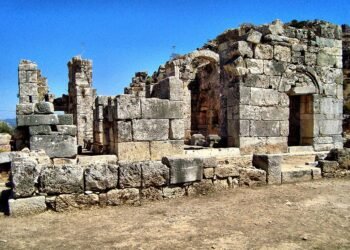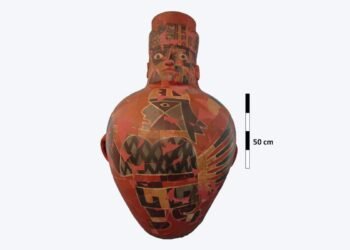Norwegian researchers have used genetic analysis to potentially identify the remains of a medieval figure described in an 800-year-old Norse saga. The study, published on October 25 in the journal iScience, analyzes skeletal remains discovered in 1938 at the Sverresborg Castle in Norway.

Researchers believe the bones may belong to a figure from the Sverris Saga, a historical prose poem documenting the reign of King Sverre Sigurdsson and recounting a dramatic incident in 1197, where a man’s body was reportedly thrown into the castle’s well to poison its water supply.
The Sverris Saga is a detailed account of the life and rule of King Sverre, who claimed the Norwegian throne in the late 12th century. This period was marked by intense battles for power, especially between Sverre’s loyal “Birkebeiner” army and a rival faction known as the “Baglers,” supported by the Roman Catholic Church.
According to the saga, during a Bagler raid on Sverresborg in 1197, attackers threw a corpse into the castle’s well—a crude method aimed at contaminating the water and rendering the fortress uninhabitable for Sverre and his men. Archaeologists initially discovered human bones in the well during excavations in 1938, though at the time they could only conduct a visual examination.

Now, a team led by Michael D. Martin, a professor at the Norwegian University of Science and Technology, has combined radiocarbon dating and genetic sequencing to examine these remains more closely. Their analysis places the man’s death around 1197, aligning with the timeline of the events described in the saga. “This is the first time that a person described in these historical texts has actually been found,” said Martin, adding that new genomic methods are making it possible to re-evaluate ancient remains across Europe.
The DNA analysis suggests that the man, known as the “Well-man,” likely had blue eyes, blond or light-brown hair, and medium skin tone. Further genetic evidence also links his ancestry to the Vest-Agder region in southern Norway—an area controlled by the Baglers, hinting that the man may have been part of the attacking force.
The researchers extracted DNA from a tooth, as the bones themselves were too poorly preserved for genome sequencing. Martin’s team collaborated with Agnar Helgason of deCODE Genetics in Iceland, comparing Well-man’s DNA with modern Norwegian and European reference genomes.
“The biggest surprise for all of us was that the Well-man did not come from the local population,” Martin said, proposing that the attackers may have discarded one of their own fallen soldiers to contaminate the well.
Researchers caution that it remains impossible to confirm with absolute certainty that these are indeed the bones described in the saga. “While we cannot prove that the remains recovered from the well inside the ruins of Sverresborg Castle are those of the individual mentioned in Sverris Saga, the circumstantial evidence is consistent with this conclusion,” the study’s authors wrote.
Anna Petersén, an archaeologist at the Norwegian Institute of Cultural Heritage Research, noted that while genetic research can substantiate historical events in a “more neutral way,” the saga itself might not be entirely factual. “The text is not absolutely correct—what we have seen is that the reality is much more complex than the text,” she explained.
Martin and his team hope to apply these methods to other historic figures. They are especially interested in St. Olaf, Norway’s patron saint, believed to be buried near Trondheim Cathedral. “If eventually his remains are uncovered, there could be some effort to describe him physically and trace his ancestry using genetic sequencing,” Martin noted.
This research reveals more about a mysterious era in Norse history, potentially validating one of the oldest accounts of biological warfare.






















